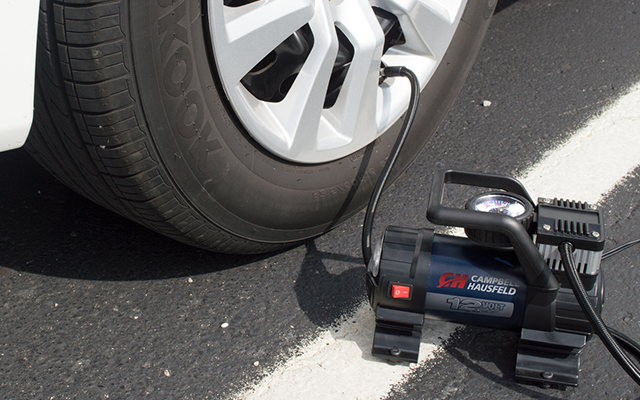
With a tire inflator, you’re ready to tackle emergencies on the roadside or in your own driveway. Inflators are affordable, portable tools that help you complete projects around the house or garage — and give you peace of mind.
Inflators, sometimes called tire inflators or portable tire inflators, are pumps that provide air. You can use them to air up car or truck tires, bicycle tires, sports balls, and air mattresses. Unlike air compressors, inflators do not have a tank and are designed strictly for inflation — not for powering air tools.
Using an inflator is simple. Choosing the best one for your needs involves asking a few questions.
12v or 120v inflator?
A key consideration in choosing an inflator is whether you want an electric inflator or a battery-powered inflator.
The obvious benefit of a battery-powered inflator is that you are not tethered to a power cord, giving you the portability and flexibility to tackle inflation jobs anywhere. Many portable inflators weigh just a few pounds and can be easily stored in a vehicle trunk or glove compartment. These 12-volt models can also be plugged into a car cigarette port for operation — providing you with peace of mind when you’re on the road.
While a battery-powered inflator offers portability, it does require a battery charge every few months to ensure it has the power to give you air on demand when you need it.
Electric inflator options have a power cord and are sometimes called home inflation systems. This 120-volt home inflation system operates on 120-volt household current and delivers up to 150 pounds per square inch (psi) of air. It can be used for inflating car and bike tires, soccer balls, beach balls, and other equipment.
Inflator ratings
Some important ratings to consider when choosing an inflator are psi and inflation speed.
- The psi rating measures the air pressure delivered by the inflator. Portable inflators typically offer 100 to 150 psi, though some models can deliver up to 300 psi. Most DIY and home inflation jobs can be completed with 100 or 150 psi. Inflating car tires, for example, typically requires 35 to 40 psi, while higher-pressure bicycle tires often require 100 to 150 psi.
- Inflation speed measures how long it takes a unit to inflate a 195/65 R15 tire from 0 to 35 psi. This figure is measured in minutes. Depending on the portable inflator model, the inflation speed may be less than four minutes, six minutes or eight minutes, for example.
Inflator options
Many portable inflators come with additional accessories, such as inflation nozzles and sports needles, to allow the unit to be used for recreation inflation tasks as well. These accessories make them multi-use tools for many jobs around your home.
Also consider the cord length and hose length offered by an inflator. The longer the cord and hose, the farther you can reach with the unit to fill whatever the task requires.
Portable inflators are also available in analog or digital models. A digital model can take the worry out of a roadside emergency by offering automatic shutoff. Simply program the desired psi level for your tire, connect the leakproof threaded air hose valve and turn the unit on. Once the desired pressure level is reached, the motor automatically shuts off. A cooling fan kicks on as needed to prevent overheating and allow for 30 minutes of continuous use.
Explore our numerous portable inflator options to find one that’s right for you.

